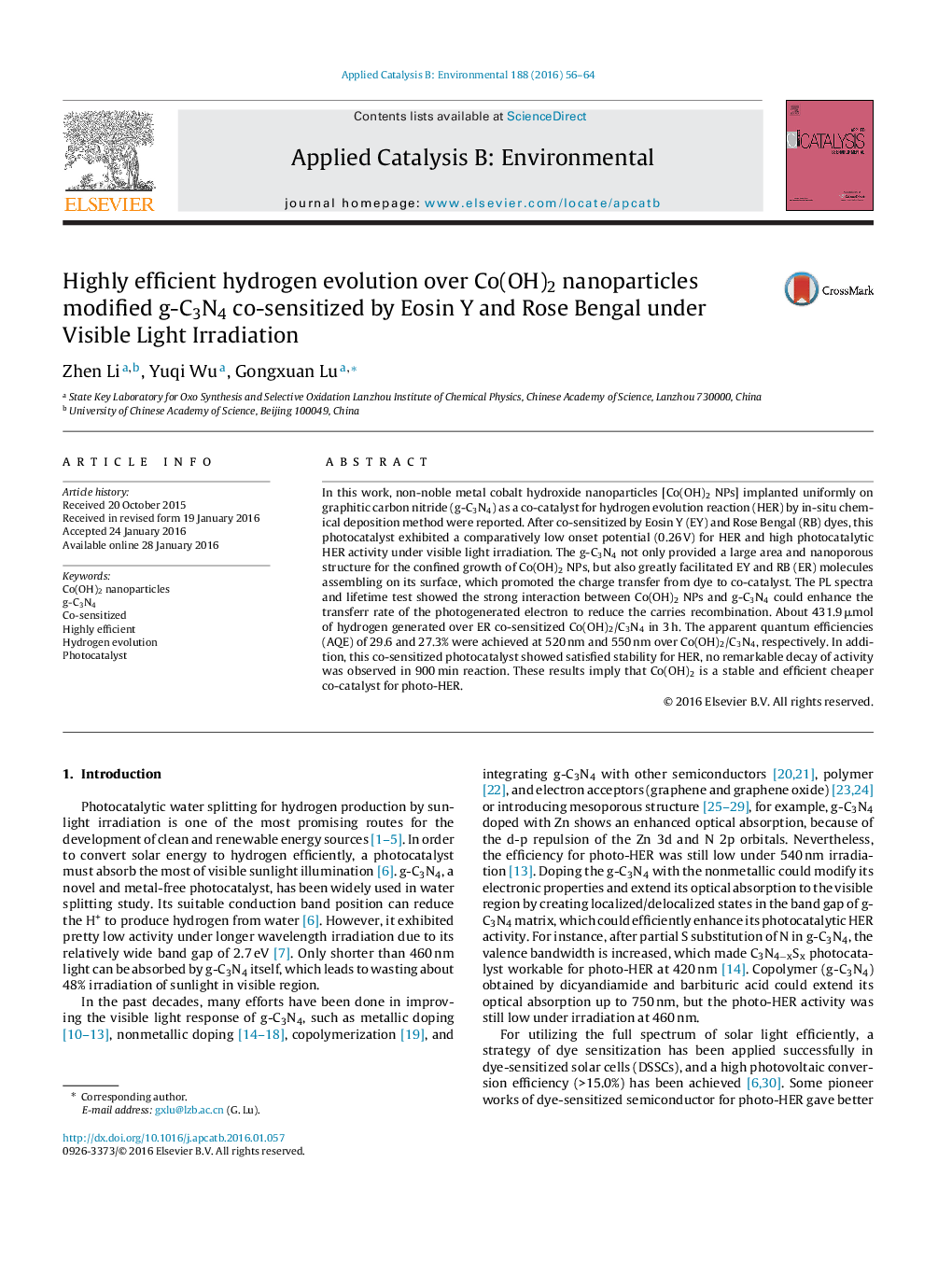| Article ID | Journal | Published Year | Pages | File Type |
|---|---|---|---|---|
| 44998 | Applied Catalysis B: Environmental | 2016 | 9 Pages |
•Co(OH)2 NPs modified the g-C3N4 for high efficient visible photocatalytic HER.•Co(OH)2 NPs modified the g-C3N4 shows a low onset potential (0.26 V).•EY and RB co-sensitization expand the light absorption rang of g-C3N4 from 400 to 600 nm.•The apparent quantum efficiencies (AQE) of 29.6 and 27.3% were achieved at 530 nm and 560 nm.
In this work, non-noble metal cobalt hydroxide nanoparticles [Co(OH)2 NPs] implanted uniformly on graphitic carbon nitride (g-C3N4) as a co-catalyst for hydrogen evolution reaction (HER) by in-situ chemical deposition method were reported. After co-sensitized by Eosin Y (EY) and Rose Bengal (RB) dyes, this photocatalyst exhibited a comparatively low onset potential (0.26 V) for HER and high photocatalytic HER activity under visible light irradiation. The g-C3N4 not only provided a large area and nanoporous structure for the confined growth of Co(OH)2 NPs, but also greatly facilitated EY and RB (ER) molecules assembling on its surface, which promoted the charge transfer from dye to co-catalyst. The PL spectra and lifetime test showed the strong interaction between Co(OH)2 NPs and g-C3N4 could enhance the transferr rate of the photogenerated electron to reduce the carries recombination. About 431.9 μmol of hydrogen generated over ER co-sensitized Co(OH)2/C3N4 in 3 h. The apparent quantum efficiencies (AQE) of 29.6 and 27.3% were achieved at 520 nm and 550 nm over Co(OH)2/C3N4, respectively. In addition, this co-sensitized photocatalyst showed satisfied stability for HER, no remarkable decay of activity was observed in 900 min reaction. These results imply that Co(OH)2 is a stable and efficient cheaper co-catalyst for photo-HER.
Graphical abstractNon-noble metal cobalt hydroxide NPs was implanted uniformly on the surface of g-C3N4 by in-situ chemical deposition method for high efficient HER. This photocatalyst exhibits a low onset potential (0.26 V) for proton reduction and high photocatalytic activity for HER co-sensitized by Eosin Y (EY) and Rose Bengal (RB) dyes. The g-C3N4 not only provides a large area and nanoporous structure for the confined growth of Co(OH)2 NPs, but also can greatly facilitate EY and RB molecules assembly on its surface, which further promotes the charge transfer from dye to co-catalyst. About 431.9 μmol of H2 generates over Co(OH)2/C3N4 co-sensitized by EY and RB in 3 h. The apparent quantum efficiencies (AQE) of 29.6 and 27.3% were achieved at 530 nm and 560 nm over Co(OH)2/C3N4, respectively. Moreover, this co-sensitization photocatalyst also showed rather stable photocatalytic activity for HER.Figure optionsDownload full-size imageDownload as PowerPoint slide
